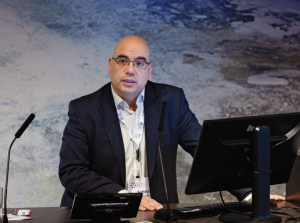Exclusive coverage from the Irish Medication Safety Network Annual Conference 2019, RCSI
Medication safety ‘now a global goal’
Late last year, the RCSI played host to the Irish Medication Safety Network (IMSN) Annual Conference 2019, the 10th year in which the event has been held. The conference, which was held under the theme ‘Medication Without Harm: Responding to the Challenge’, was chaired by Ms Pat O’Brien, IMSN member and Medication Safety Co-Ordinator at Galway University Hospitals.
Ms O’Brien introduced Ms Marita Kinsella, Director of the National Patient Safety Office at the Department of Health. Ms Kinsella referred to the “shared goal, which is indeed a global goal now, of ensuring the safety of medications” and in keeping with the range of healthcare professionals attending the conference, she emphasised the need for a multidisciplinary approach to medication safety.
“Collaboration between healthcare professionals, patients, policy-makers, regulatory bodies and everybody else involved in the medication process is vital in promoting patient safety and responding to the global challenge that is medication without harm,” said Ms Kinsella. “The IMSN demonstrates the importance of that collaboration by promoting the exchange of information on medication safety and facilitating national initiatives to help minimise risks to patients.
“Over the years, we have seen the benefits of IMSN collaborations, with the publication of medication safety briefings and alerts, development of guidance on the management of identified high-alert drugs, and ‘sound-alike’ and look-alike’ medicines,” she told the conference. “The IMSN has led on a number of really important safety initiatives over the past year, but I particularly want to commend the IMSN on [the initiative] ‘Building a Medication Safety Programme in a Hospital in Ireland — Fundamental Steps’… I want to recognise the IMSN’s leadership in building a guidance document that provides hospitals with the building blocks to design a safety programme and thereby give practical advice in addressing HIQA’s medication safety recommendations.
“It is this kind of collegiality and collaboration that is essential in our health service to embedding a culture of patient safety and quality.”
Ms Kinsella told the attendees that the Department of Health is contributing to EU-level efforts to “consider initiatives” to minimise the risks to patients and also the impact on healthcare professionals of medicines [supply], the most serious issue facing the health service arising from Brexit,” she said. “Brexit will affect all of us, but in relation to medicines and medical devices, the Department is confident that people will continue to have access to high-quality, safe and effective medicines and medical devices. In some limited circumstances, we may need to use therapeutic alternatives but if this is necessary, it will be informed by expert clinicians in their respective medical specialties and the expert role of pharmacists and those of you with expertise in the safe use of medicines will be critical in ensuring that we minimise the impact of Brexit for Irish patients.”
Ms Kinsella also addressed the increasing importance of open disclosure and told the attendees: “It’s very heartening to see that the IMSN is engaging in a very real way on open disclosure and what it means with regard to the safety of medicines,” she said. “As a health service, openness and honesty with patients must be at the heart of everything we do. Open disclosure must happen in the right way and in all circumstances — patients have to be informed.
“We have seen all too clearly arising from a number of serious patient safety incidents over recent years the impact that failure of open disclosure can have on patients. It’s important that we’re all committed to learning from these events and embedding a culture of ensuring that patients are treated in a way that they would most like to be treated when things go wrong, that they perceive a sincere and genuine apology, and to be sure that what has happened to them will not happen to anybody else,” she continued.

“We need to ensure that the culture of trust and confidence between patients and clinicians prevails. Within the team at the National Patient Safety Office, we have been working on a new patient safety bill, which will focus on mandatory open disclosure of the most serious patient safety incidents. This will ensure that patients and their families affected by a serious incident will be assured of receiving appropriate and timely information in relation to an unintended or anticipated serious event that may have occurred in relation to their care.”
Ms Kinsella added that the mandatory disclosure bill will also require notification of the most serious patient safety events and incidents to HIQA and the Mental Health Commission, as appropriate, to ensure system-wide improvements. However, she described the legislation as a “blunt tool” to embed a culture of openness and transparency in cases of serious incidents.
“Ensuring that patients and their families are treated honestly and openly when things go wrong also requires personal commitment from all of us who work in the health service,” she said.
Electric dreams in medications prescribing
The IMSN Annual Conference 2019 heard from Mr Paul Tighe, IMSN Chair and Head of Pharmacy at St Vincent’s University Hospital, Dublin. Mr Tighe provided an overview of the IMSN and its activities during 2019 and told the attendees: “The IMSN is an entirely voluntary network and people are surprised when they hear that,” he said. “Our full-time roles are in the hospitals in which we work — this is a collection of hospital pharmacy-based specialists from all the hospitals, not just the public ones, but also private ones. That’s very important, that we are very representative of all of the hospitals.”
The Network promotes medication safety through the exchange of information, as well as national and international initiatives and during 2019, the Network published safety alerts on medication safety in pregnancy; tamoxifen and the potential for drug-drug interactions; medications for Parkinson’s disease; and a fresh review of intravenous (IV) paracetamol. “We were particularly keen to review IV paracetamol and look at risks relating to dose-adjustment and risks around IV paracetamol use in children,” said Mr Tighe.
For the start of this year, there is a working group focused on medication safety in operating theatres and another group focused on medication safety in the Electronic Health Record (EHR). “That’s very relevant when you take into account the number of hospitals that are moving towards using an EHR, particularly in the maternity sector,” he explained.

Mr Tighe presented national State Claims Agency data to show that of the clinical incidents that were reported to NIMS during 2018, one-in-four were incidents that related to medication errors. Citing more data from the NIMS Clinical Insights report, Mr Tighe told the conference that regarding the areas in which medication errors were occurring during the medications use process, one-in-two such incidents happened at the prescribing stage. “That’s highly relevant, considering that prescribers traditionally report the least amount of incidents, but it’s also important when you consider where we are going with medication safety,” said Mr Tighe.
“We have spoken at previous conferences about the hierarchy of intervention and about telling people to be more careful, to introduce some policy in practice, but the more we can engineer things out of the system, the safer they will be,” he said. “Every time we get a new recruit of medics, pharmacists or nurses in our hospital, we have to go through the same processes.”
Mr Tighe told the attendees that the most important development in the past three years in Ireland in medication safety has been the strategic decision by HIQA to commence medication safety inspections and monitoring visits in public hospitals. “This has been a significant programme that has really shone a light on all of the issues around not only medication safety, but also clinical pharmacy,” he said. “At the moment, I believe there have been approximately 60 inspections, 54 of which are on the HIQA website. We have been given a gift from HIQA; 12 recommendations, seven of which are hospital-level and five that are national.
“We are quite good at some of these [recommendations] and we have made some progress on the national recommendations, particularly in sharing and learning from medication incidents, and also in trying to use electronic solutions where we can,” he continued. “But there are two that I would like to flag. The medication safety monitoring visits were as much about medication safety as they were about clinical pharmacy. Another recommendation that we have is to develop a national plan for comprehensive clinical pharmacy services — it’s a huge task to do that, but it is also a huge opportunity in terms of the benefit that we will have if we can standardise some of the clinical pharmacy across all of our hospitals, regardless of the size of the hospital, and also the different types of scale that we deal with.”
Regarding one-in-two errors being at the prescribing stage of the medicine process, Mr Tighe spoke to the attendees about electronic prescribing. “We have seen significant progress with the NCIS [National Cancer Information System] and in maternity, and I think now is the time for all the hospitals to make a huge effort to move towards EPMA [electronic prescribing and medicines information] and to try to push the EPMA agenda as much as we can,” he stressed.
“There are only so many times we can train our prescribers and encourage people around medication safety but if we have EPMA, we can introduce decision support, we can introduce ‘forcing functions’, and we can try to encourage safer prescribing.” In this regard, Mr Tighe offered St James’s Hospital in Dublin as an example that other hospitals could follow.
Unpublished data shows significant improvements in hospital medication safety
The IMSN Annual Conference 2019 also saw a joint presentation titled ‘Collaborative Approach to Reducing Hospital-Acquired Venous Thromboembolism from a Patient, Clinician and Group Hospital Manager Perspective’. The attendees were given different perspectives on this topic from Ms Annemarie O’Neill of Thrombosis Ireland, Prof Fionnuala Ni Ainle, Consultant Haematologist at the Mater Misericordiae University Hospital and Rotunda Hospital in Dublin, and Prof Mary Day, CEO of the Ireland East Hospital Group.
This was followed by a presentation by Ms Aoife Lenihan, Regional Manager of Healthcare Regulation with HIQA, who spoke on the theme ‘HIQA Phase II Medication Safety Monitoring in Hospitals’. Ms Lenihan provided an overview of this phase of the programme, which has been running for four years, and said the public must be fully assured that national standards in medication safety are being met. For pharmacists who seek details of the programme, Ms Lenihan urged them to consult a guidance document published by HIQA on its website.

Ms Lenihan presented some previously-unpublished information on some findings from the past two years and told the seminar: “In that time, we have conducted 20 inspections in 19 hospitals, visiting one hospital twice in that time-frame,” she explained. “Comparing what we found in 2016 and 2017 in relation to governance, in the first two years of the programme, we estimated that approximately 60 per cent of the hospitals that we inspected had a functioning drug and therapeutics committee. When we went back out in 2018 and 2019, this had significantly improved, in that all 19 hospitals had these functioning committees.
“In the first two years, we found very few hospitals had a formal medication safety strategy to be very clear on what the short-, medium- and long-term goals were for a particular hospital,” said Ms Lenihan. “This had improved to 10 hospitals having a very structured and clear strategy in the past two years and it’s fair to say the hospitals that had not formally developed a strategy had ways whereby they could identify their priorities, articulate them, and they had action plans to track improvement to ensure they were working in a systematic way to achieve those goals.”
Quality of risk management system was shown to be “very solid” across all hospitals over the past two years, Ms Lenihan said, including risk registers to escalate high-risk issues in medication safety and analysis of incident reports, however she revealed that proactive risk assessments were quite rare.
“These were more common in the ‘leading’ hospitals, where instead of focusing on just incident reporting, there was a focus on what could potentially go wrong and taking proactive measures. This is an area that could potentially be improved.”
Most of the hospitals showed increases in incident reporting, but the culture of reporting can always be improved, said Ms Lenihan, who pointed out that pharmacists and nurses most often reported safety incidents. On the day of inspection, samples would be looked at from eight high-risk medications identified by HIQA, including anticoagulants. “These are the highest-risk medications that perennially come up in incidents and the only medications that we identified in very serious events,” she explained. In this regard, policies and protocols were designed to guide staff and avoid inadvertent double-dosing.
It was also decided that for the first time, the inspection team would visit operating theatres, said Ms Lenihan, and areas that provide procedural sedation outside of the theatre. “In-theatre is a unique situation, where there are multiple high-risk medications, high patient throughput and complex procedures, which makes it a very high-risk area,” she said. “In general, the drawing-up and labelling of syringes was in line with best practice… hospitals were using internationally-recognised labelling systems and in general, practitioners were drawing-up drugs and using them themselves, rather than leaving them for another practitioner, and they were maintaining custody of those drugs and disposing of them at the end of a procedure.”
However, while a limited number of sites were inspected for procedural sedation, the inspection team found variations in governance and oversight, with only two hospitals having a specific procedural sedation safety committee. Procedural sedation in endoscopy is generally “very well done,” Ms Lenihan added. Overall, the inspections also revealed increases in medications reconciliation and “where there is a clinical pharmacy service, medication safety is greatly improved,” she said. Five of the 19 hospitals inspected had a very limited or purely dispensing pharmacy service and hospitals that did not have a formulary are working on developing local formularies, while most hospitals had access to information for staff at the point of care, she said.
However, some hospitals’ medication safety monitoring was limited to using nursing metrics and Ms Lenihan told the conference in conclusion: “I’m sad to say that the medication safety monitoring in its current guise will conclude in 2020, when we will have done more than three years of work,” she said. “But on a positive note, it’s not something that we will leave behind. We plan to work on and develop our approach to monitoring and this is something we will maintain; whatever way our monitoring approach changes… there will need to be a lot of communication with stakeholders, including yourselves, and stakeholder engagement in changing the way we monitor hospitals.”
At the heart of anticoagulation
The IMSN Annual Conference 2019 also heard from Mr Sotiris Antoniou, Consultant Pharmacist in Cardiovascular Medicine and Chair of the International Pharmacists Anticoagulation Taskforce (iPACT), UK. Mr Antoniou provided an overview of collaborative care in anticoagulation and provided a number of case studies to illustrate how collaborative work can help to improve patient outcomes.
“With the NOACs, there is some good data to show that even after one year of treatment, the discontinuation rate is between 33 and 50 per cent,” said Mr Antoniou. “In fact, if you look at the trials on NOACs in stroke prevention and atrial fibrillation (AF)… the discontinuation rate due to adverse events is approximately 20-to-25 per cent in a randomised, clinical trial. So we are not surprised that these figures are replicated in the general population.”
Regarding in medicines that cause hospitalisations due to an adverse event, he told the attendees that anticoagulants “will always be seen in the top-three, if not the number-one… warfarin is the number-one drug associated with hospitalisations in US hospitals. As you might expect, the majority of the reasons for this related to bleeding and the number-one concern was around intracranial haemorrhage.” The average INR for a person taking warfarin and admitted to hospital with an intracranial haemorrhage is typically 2-to-3, he said.

Along with the ageing population, rates of AF are increasing and Mr Antoniou referred to international guidelines, which state that opportunistic screening for AF in patients aged over 65 years, involving pulse-taking followed by an ECG, is recommended to allow timely detection of the condition. In 2016, iPACT organised for hospitals and community pharmacies in five countries to run pulse awareness initiatives, he added.
One challenge for hospital pharmacists is that patients are rarely on the same medicines they end up taking on discharge, said Mr Antoniou, who spoke about the iPACT interprofessional guidelines on anticoagulation.
“Among the top recommendations are the importance of communication in the transfer-of-care between healthcare settings; ongoing medications adherence; medicines reconciliation; and medications review. We know that transfer of care is a particularly high-risk area because of lack of communication or inconsistent communication.”
Healthcare staff often the ‘second victims’ in adverse incidents
The IMSN Annual Conference 2019 heard presentations from Mr Dan Burns, Pharmacy Director at Pharmapod, on the theme ‘Advancing the Global Patient Safety Agenda’ and Ms Ciara Kirke, Clinical Lead at the National Medication Safety Programme at the HSE, who delivered an overview of ‘The Know Check Ask Campaign — Mobilising People Power for Medication Safety’.
Attendees also heard a presentation from Ms Ann Duffy, Senior Clinical Risk Advisor at the State Claims Agency (SCA), who spoke on the topic ‘Medication Safety and Open Disclosure — An Evolving Landscape’. Ms Duffy told the conference that staff often do not get the supports they need following an adverse event, leading to them sometimes being described as “the second victim”. She told the attendees: “Medicine is dynamic, it is evolving, it’s complex. We are always going to have incidents and we are always going to have claims. What we need to focus on is how we react to those incidents and claims and how we manage our staff following those events.”
A lot of the SCA’s work revolves around data and the National Incident Management System (NIMS) to identify trends and mitigate potential risks, as well as the nature of claims and how they came about and a recurring theme is poor communication or lack of communications. In pharmacy, incorrect prescriptions and errors around drug dosage are also recurring themes, said Ms Duffy.

She described the “domino effect” adverse events can have on staff and she outlined the top-10 injuries in acute services, such as cuts, lacerations and postpartum haemorrhages. In terms of medication incidents, she told the attendees: “There were only 10,000 reported in 2018 and it will be similar for 2019, so we are well aware that the ‘iceberg’ is there and we are only seeing the very tip of it.”
On the topic of who reports incidents most, Ms Duffy said: “Clinical pharmacists are picking up a lot of these medication incidents at ward level, followed by nursing and midwives and doctors… ” She outlined 48 claims made between 2011 and 2016 and estimated the costs of these to be around €3 million, however the legal and expert costs often equal or exceed the amount a plaintiff will receive.
Ms Duffy presented a case study to illustrate a claim of negligence, pointing out that for negligence to be proven, it must be established whether a duty of care existed in the first place. She also outlined a definition of actions to be taken on adverse incidents from Australian authorities, which includes “expressing regret for what happened, keeping the patient informed, providing feedback and taking steps to prevent recurrence.
“Open disclosure is about good, effective communication with patients and their families.” Patients should be told quickly about medication errors rather than waiting for a process to begin, which could take days or weeks, she said.
“Medicine is complex and incidents will continue to happen,” Ms Duffy concluded. “When things go wrong, we have to know how to look after our staff and help them. I say this to a lot of students — no-one is immune to being involved in an incident. Practical and timely support are important — there is the ASSIST model, which I myself used recently, and confidential settings are important for staff to discuss an incident and how it affected them… debriefing is also important and occupational health has a role in this area, as do employee assistance programmes.”
Pharmacists front-and-centre in medication safety
Regional Manager of Healthcare Regulation at HIQA Ms Aoife Lenihan has said that pharmacists are leading the way in striving for medication safety in Irish hospitals. Ms Lenihan was speaking with Irish Pharmacist (IP) following her presentation at the IMSN Annual Conference 2019, which was titled ‘HIQA Phase II Medication Safety Monitoring in Hospitals’.
Ms Lenihan commented: “From what we see on inspection, pharmacists [as part of the multidisciplinary team] are leading the way and are very often the drivers for medication safety. We also made the point in our overview report in 2018 that there are gaps in clinical pharmacy services and we have included this as a national recommendation.”
Ms Lenihan also touched on the general public awareness of the importance of hospital pharmacists in patient care in comparison to the high level of awareness that exists around the value of community pharmacists. “There is definitely potential to raise awareness in this regard,” she said. “Anything in the public domain that raises awareness of the role, and promotes the role of clinical pharmacists within a hospital setting, and to educate them about the evolving role of pharmacists over the years within hospital care is good, as well as highlighting their important role in ensuring medication safety.”
Ms Lenihan was also asked about the fact that medication safety monitoring in its current guise will conclude in 2020, and what her hopes and aspirations may be when that happens in terms of the continued drive for medication safety. “Back in 2016, this was identified as a key area for HIQA to focus its monitoring programmes on,” she told IP, “so future monitoring of healthcare by the healthcare team will include aspects of medication safety.”







